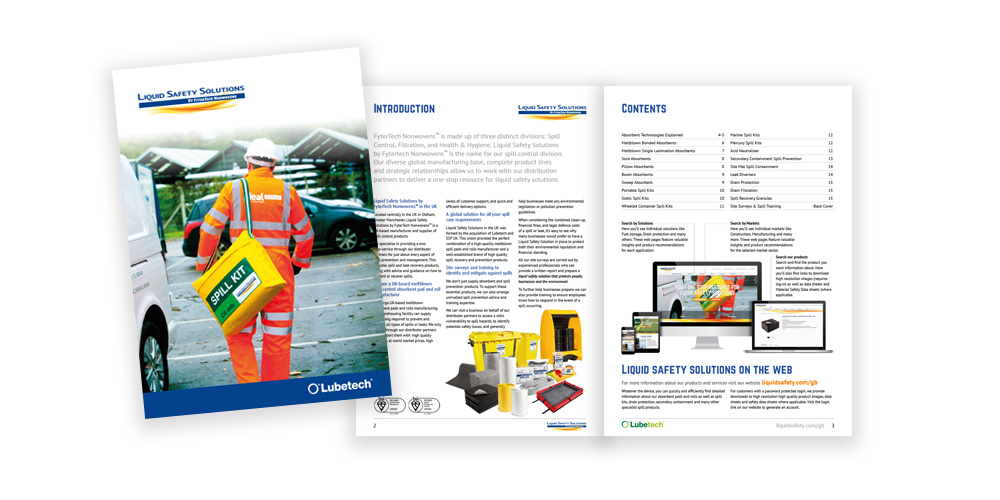Construction
Spill Control Solutions for Construction
For the construction industry there are a number of things to consider when protecting people and the environment from the effects of spilled and leaked fluids.
Maintaining site safety and protecting the environment requires forward planning and consideration of the site’s location with regard to preventing pollution from contaminating the surrounding land and drainage systems.
The wide variety of applications, fluid types and uses involved in construction means that both absorbents and spill prevention products are equally of importance.
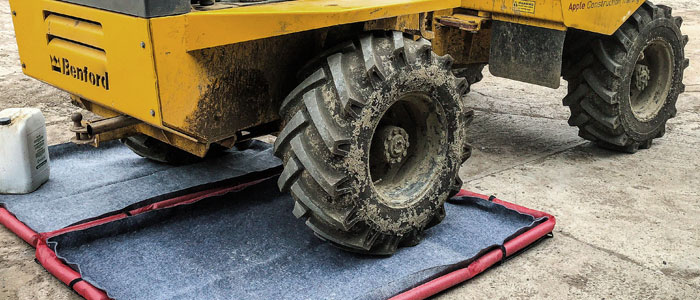
What type of absorbent is best suited for Construction?
Essentially the fluids involved in construction are oil-based fuels and solvents as well as water-based precipitation run-off that can be contaminated with either silt or oil-based pollutants.

White coloured Oil Only absorbents are hydrophobic. They absorb oil-based fluids but repel water-based fluids. For locations outside, subjected to weather exposure, Oil only absorbents are particularly suited to recovering just oil-based fluids without soaking up any falling or pooled precipitation.

Grey/black Maintenance absorbents are hydrophilic and take up both water-based fluids along with oil-based fluids at the same time. These are the best all-round option for recovering spills or liquids of any type.
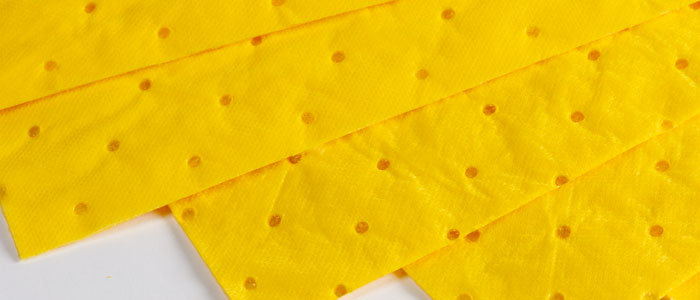
Yellow Chemical absorbents are also hydrophilic and will absorb both oil- and water-based fluids at the same time. The yellow colour of these absorbents indicates that they should be used for recovering aggressive fluids such as acids and alkalis and once used should be treated and disposed of with extreme caution.
Oil only white absorbents are particularly suited when refuelling or servicing; machinery, plant, vehicles or equipment.
In most instances a Maintenance grey/black absorbent will be the optimum choice for cleaning and recovering the widest possible range of water-based spilled fluids. Laminated pads are stronger so are better suited to repeated scrubbing of hard or rough surfaces.
Yellow chemical absorbent is best to have available if aggressive substances like acids or alkalis are present. Most often a Chemical spill kit will be the best option for these kinds of spills.
All of the above formats are made from meltblown polypropylene. They are inert and will not react with chemicals and are flame retardant (they will however burn if incinerated).
Environmentally friendly options
As an alternative to the above we offer a range of environmentally friendlier absorbents. These are either made from recycled meltblown polypropylene or are made from cellulose natural fibres. These environmentally friendly absorbents can be included towards achieving an ISO 14001 Environmental Management Standard.
Natural fibre absorbents are in some cases more absorbent. However, choosing an environmentally friendly absorbent needs to be considered carefully as a used or contaminated absorbent will need to be disposed of exactly the same way as a meltblown polypropylene absorbent.
What absorbent formats are best suited to Construction?
Pads are available in different weights (light- through to -heavy weights) and also in un-bonded, bonded and laminated constructions. As a guide the heavier the weight the more fluid the pad will absorb. With regards to the construction, laminated pads are stronger and feature less linting (stray fibres becoming detached), bonded pads are slightly more absorbent, and un-bonded pads the most absorbent but not as strong. For wiping or scrubbing we generally recommend a medium weight single laminate Maintenance or Oil only pad depending on the use and fluid to be recovered. All but the un-bonded pads feature perforations so that just the correct amount of absorbent can be selected.
Rolls are exactly the same as pads but instead are formed of continuous lengths of absorbent which are rolled up. Rolls of absorbent are ideal for rolling out over larger areas to collect spilled or leaked fluids next to machinery. We recommend a single laminate absorbent with the meltblown core face down. This maximises the absorption of fluids whilst reducing the slip risk. Rolls of absorbent are also useful for protecting surfaces.
Socks and Pillows are used to collect spills or leaks from around or beneath vehicles or machinery. Socks are used to contain the fluid by providing a barrier whilst also absorbing the liquid. Pillows are for capturing leaks or spills under machinery that are too big for a pad.
Drum tops are placed inside the top rim of a standard 210 litres (55 gallon) drum. They feature apertures for both pouring and breather holes.
Site Mat is a two-part unit which is placed under plant or equipment when being refuelled or serviced. An inner polypropylene liner filters and traps the fuel or oil-based liquid while the porous side walls allow rainwater to simply run off.
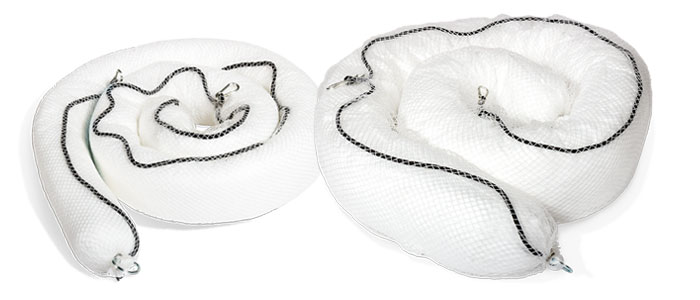
Booms and Bilge Booms are flexible tubes of absorbent that can be floated on the water surface to surround and prevent spills or leaks from spreading whilst also absorbing the oil-based fluid. These are available in different lengths. Eyes and snap-hooks allow multiple booms to be attached together to form long floating barrages. A 13cm diameter boom is available for inshore or inland water locations such as rivers, ponds or lakes. A smaller bilge boom is also available which can be placed in water drainage courses to filter out oil-based fluids.
Sweeps are long ‘curtains’ of polypropylene that are designed to be towed behind a boat or secured across a water course to collect the final sheen of oil from the surface of the water.
Liquid spill solutions to prevent spilled or leaked liquids from entering drains and water courses
These products form a barrier to prevent the spill or leak from entering into drains.
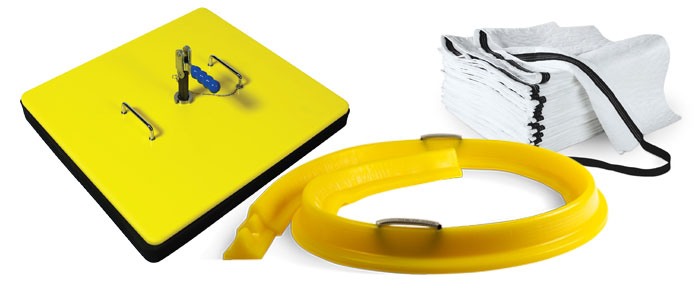
Drain covers are available in mechanical, soft and malleable plastics, or bentonite clay. They can be moulded to the surface around the drain to prevent fluids from running into the water system.
Spill Berm is a length of flexible raised plastic with a flat base. It can be located around the perimeter of a drain to divert or hold back any spilled or leaked fluids. Interlocking ends mean that multiple spill berms can connected together to form longer lengths. As with the drain covers above the spill berm is also reusable.
Oil and Sediment Drain Guard is a polypropylene fabric membrane that sits inside the drain. It has an added benefit that as well as catching sediment and any oil-based spilled fluids it also allows water to flow through it and on into the water course.
Oil and Sediment Sock is a long tube of polypropylene material that water is pumped through. The ‘sock’ traps sediment and any oil-based fluids whilst allowing filtered water to pass through the side walls. The sock also has the benefit that is can be used multiple times until the filter material becomes completely contaminated with oil-based residue.
Safety-first High-Visibility absorbents
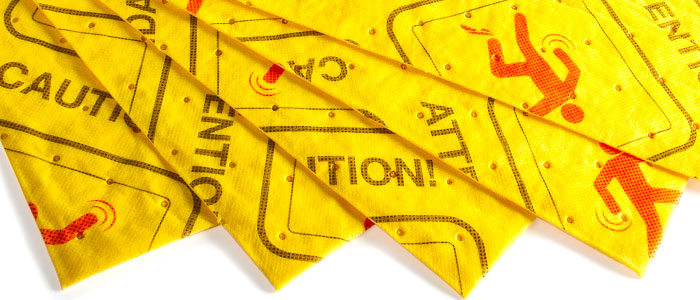
Our Spillfyter high-visibility range of absorbents are perfect for drawing attention to and warning of the slip-risk of spilled or leaked fluids whilst also recovering the spill or leaked fluid. These high visibility absorbents can be used at indoor locations during refurbishment projects to protect the workforce and members of the public from slips due to spilled or leaked fluids.
Bright yellow in colour, these absorbents will recover both oil-based and water-based fluids. They are made from meltblown polypropylene, which ensures they will not react with any chemicals present so are a perfect go-to first choice.
For unplanned liquid spills the high-visibility absorbent with warning text in three languages and graphics warns of the slip risk and recovers the leak or spill at the same time.
This range is available in pads, rolls, and wipes. They also feature a handy range of boxed dispensers and warning stands.
Protecting the workforce
To keep the workforce safe from slips, trips or injuries it is important to have enough absorbent available to recover spills. In most cases a spill kit provides what is required in a pre-packed container.

Portable spill kits can be taken to the spill location or stored on-board a vehicle. These take the form of clip-close spill kits in either 15, 20 or 30ltr sizes. A vinyl satchel 50ltr edition is also available.
Static spill kits can be located where there is known a risk of a spill occurring. These will be more suited to refuelling locations.
Wheeled spill kits allow a large quantity of absorbents to be quickly moved to the site of a spill. These range from 120ltr wheelie bins up to four-wheeled 1,000ltr versions. These would be particularly suited to building refurbishment projects where it is important to protect the project from significant pipe bursts.
Hygienic spill kits are designed to recover bodily fluids. These are particularly suited for having in site offices or first aid posts.
Spill prevention equipment
To keep fluids containers safely stored, we have an extensive range of containment and storage units. These provide secure, robust solutions for a wide varied range of containers.
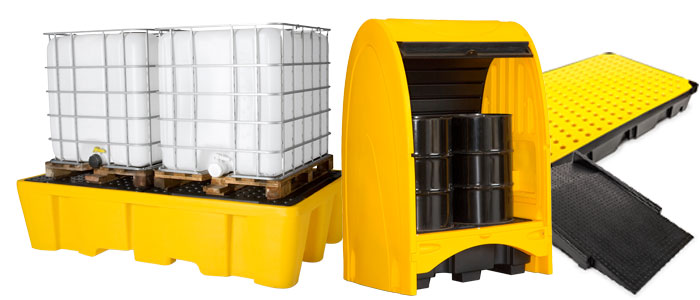
Workfloors are modular units with an integral sump built in. The sump catches any spilled fluids and can be drained off or recovered. Available in a range of sizes and with access ramps, they provide a flexible and reliable solution for accessing and storing drum and containers.
Spill Pallets are designed to store fluid contains such as drums and IBC caged containers. They also feature regulation compliant sump capacities to capture any spilled fluids. Available in a wide range of sizes and for different containers they are a regular feature on many construction sites. There are weathertight options too, which prevent rainwater filling the sump if stored outside.
Transporter units allow drums and containers to be transported around a site safely. They feature a regulation compliant built in additional fluid barrier capacity to prevent spilled fluids from reaching and polluting the environment.
Storage
We have a wide range of storage cupboards in metal and plastic. Available in different sizes and shapes, ask us for more details to suit specific requirements.
The law from the HSE
The Health and Safety at Work etc Act 1974 (HSWA)
The Health and Safety at Work Act 1974 requires employers to ensure the health and safety of all employees and anyone affected by their work, so far as is reasonably practicable, which means balancing the level of risk against the measures needed to control the risk in terms of money, time or trouble. This includes taking steps to control slip and trip risks.
Employees have a duty to take care of their own health and safety and that of others and must use any safety equipment provided.
Health and Safety at Work etc Act 1974
The Management of Health and Safety at Work Regulations 1999 (Regulation 3)
Build on the HSWA and include duties on employers to assess risks (including slip and trip risks) and take action where necessary.
Management of health and safety at work
The Workplace (Health, Safety and Welfare) Regulations 1992 (Regulation 12)
Require floors to be suitable, in good condition and free from obstructions. People should be able to move around safely.
The Workplace (Health, Safety and Welfare) Regulations 1992
Site Surveys and Spill Recovery training
To help you identify spill and leak risks we can provide a site survey. An experienced and highly knowledgeable member of our team can attend a business site and provide a written report identifying the risks. Along with the risk identification, a suggestions of liquid safety solutions will be suggested.
To allow a business’s employees to better respond to a spill we provide spill training to ensure that in the event of a spill everybody knows how to safely respond and follow a set procedure.


